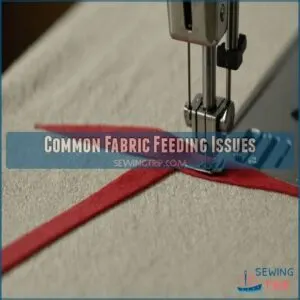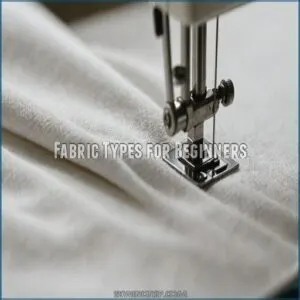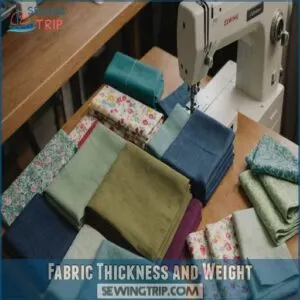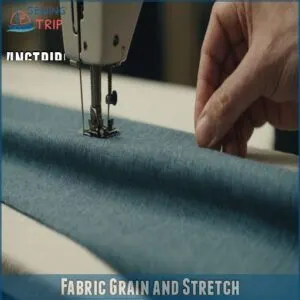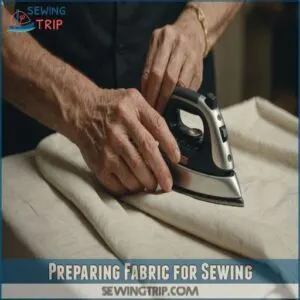This site is supported by our readers. We may earn a commission, at no cost to you, if you purchase through links.
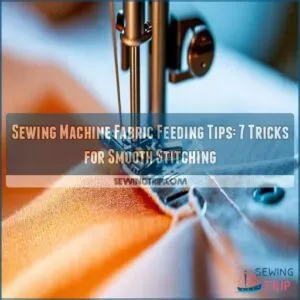
First, check your feed dogs—they’re the tiny teeth that grip your fabric. Make sure they’re up and free of lint.
Next, adjust your stitch length; sometimes shorter isn’t sweeter.
Keep your presser foot down and at the right pressure for your fabric.
A bent or dull needle can also cause hiccups, so inspect it closely.
Remember, different fabrics have different personalities—some need a gentle touch, while others can take a firmer hand.
There’s a whole world of fabric-feeding finesse to explore!
Table Of Contents
Key Takeaways
- Check your feed dogs regularly to ensure they are clean, properly aligned, and at the right height for smooth fabric feeding.
- Match your fabric type, thickness, and stretch to your machine’s capabilities, adjusting tension and presser foot pressure accordingly.
- Prepare your fabric by cutting accurately and ironing out wrinkles to guarantee smooth feeding through your machine.
- Clean your feed dogs after every project or 8-10 hours of sewing to maintain optimal performance and prevent fabric feeding issues.
Common Fabric Feeding Issues
You’ll often encounter fabric feeding issues when sewing, from stubborn feed dogs to tangled threads. Understanding these common problems will help you troubleshoot quickly and keep your projects running smoothly.
Feed Dog Problems
Struggling with fabric feeding? When understanding how to troubleshoot and maintain your sewing machine’s feed dogs, as described in feed dog troubleshooting steps, can be quite helpful. Let’s tackle those pesky feed dog problems head-on. Your sewing machine’s feed dogs, which are metal teeth-like ridges that grip the bottom fabric and assist in moving it through the machine as explained in feed dog basics, are essential for smooth stitching, but they can sometimes act up.
If you’re having persistent issues, you might want to check out resources like a guide to feed dog issues to see if there are any common solutions you haven’t tried.
Here’s a quick troubleshooting guide:
- Check feed dog height and alignment
- Make sure they’re engaged and not worn out
- Clean and lubricate regularly
- Adjust presser foot pressure to achieve optimal stitch quality and smooth fabric handling, like setting the ideal 5/16 inch space between the presser foot and throat plate using a presser foot gauge. Adjust presser foot pressure
Don’t let feed dog issues derail your project. With these tips, you’ll be back to smooth sailing in no time.
Thread and Tension Issues
Now that your feed dogs are in check, let’s tackle thread and tension troubles.
Ever felt like your fabric’s playing tug-of-war?
That’s often a tension issue.
Start by rethreading your machine from scratch.
Make sure your thread weight matches your fabric and needle size.
Adjust the tension dial bit by bit, testing on scrap fabric until stitches look balanced.
Remember, patience is key – you’ll be stitching like a pro in no time!
Power and Presser Foot Issues
With your foot on the pedal, you’re ready to sew, but nothing’s moving? Let’s troubleshoot.
First, check if your presser foot is down – it’s your fabric’s dance partner. Adjust its pressure for thicker fabrics.
No power? Inspect your cord and outlet.
If the motor’s humming but fabric’s stuck, clean and oil those feed dogs. They’re the unsung heroes of smooth stitching.
Remember, a well-oiled machine is a happy machine!
Choosing The Right Fabric
You’ll find that choosing the right fabric can make or break your sewing project.
Fabric type, thickness, and stretch are important factors to consider.
These factors will guarantee smooth feeding through your machine and achieve professional-looking results.
Fabric Types for Beginners
Ready to tame those fabric feeding issues? Let’s talk fabric types.
Natural fibers like cotton are your best bet when starting out, as they’re often more breathable and easier to care for, especially when compared to synthetic fibers like polyester alternatives.
They’re easy to handle and forgiving.
Woven fabrics, like cotton and linen, are more stable than knits.
They’ll glide through your machine like butter.
Silk
Fabric Thickness and Weight
Tackle fabric thickness and weight like a pro.
You’ll save yourself headaches by matching your fabric to your machine’s capabilities.
Here’s what to keep in mind:
- Lightweight fabrics need a gentle touch and lower tension
- Medium-weight fabrics are your all-rounders, suitable for most projects
- Heavy fabrics require a sturdy needle and higher presser foot pressure
Don’t let bulky fabrics intimidate you.
With the right settings and a bit of practice, you’ll be stitching through denim like butter.
Fabric Grain and Stretch
Understanding fabric grain and stretch is like decoding a secret language.
You’ll avoid fabric feeding issues by aligning the grain line properly.
Check the stretch direction; it affects how your fabric moves through the machine.
Consider using stretch fabric like spandex or knit for projects that require flexibility, which can be found at online stores for stretch fabric supplies.
For tricky fabrics with bias or high stretch,
Preparing Fabric for Sewing
You’ll save yourself a lot of headaches by properly preparing your fabric before sewing.
Start by cutting your fabric accurately.
Iron out any wrinkles to guarantee smooth feeding through your machine.
Cutting and Ironing Fabric
The secret to smooth stitching lies in your prep work.
Before you start sewing, take time to cut and iron your fabric properly.
Use sharp fabric cutting tools like rotary cutters for precise edges.
Then, press your fabric with the right ironing techniques to make sure it’s flat and crease-free.
This prep work sets the stage for seamless fabric feeding.
- Feel the satisfaction of crisp, clean cuts gliding through your fabric.
- Experience the zen-like calm of smoothing out wrinkles with a warm iron.
- Imagine the pride of starting your project with perfectly prepped materials.
Removing Wrinkles And
Wrinkle-free fabric is key to smooth stitching.
You’ve cut and ironed your fabric, but those pesky creases still lurk?
Let’s banish them for good.
Here’s a handy guide to keep your fabric smooth as butter:
If you’re looking for a quick and easy way to eliminate wrinkles, consider using a fabric spray for a smooth finish.
| Method | Pros | Cons |
|---|---|---|
| Steaming | Quick, effective | Potential water spots |
| Pressing | Precise control | Time-consuming |
| Fabric spray | Easy to use | May affect fabric feel |
Remember, a wrinkle-free start leads to flawless finishes.
Your feed dogs will thank you!
Frequently Asked Questions (FAQs)
What Type of Fabric is Easiest for Beginners to Learn On?
Cotton is your go-to fabric for learning to sew.
It’s stable, easy to handle, and forgiving of mistakes.
You’ll find it’s a breeze to cut, pin, and stitch, making your first projects a joy to create.
My Fabric Keeps Slipping and Sliding Around. What Can I Do?
Slippery fabric got you in a tizzy? No worries!
Try using a walking foot attachment or tissue paper underneath.
You can also adjust presser foot pressure, use fabric stabilizer, or pin generously.
These tricks’ll keep your fabric steady as she goes!
I Don’t Have a Walking Foot. Are There Any Other Tools I Can Use?
You’ve got options! Try a Teflon foot for slippery fabrics or a roller foot for tricky textures.
Even strips of tissue paper can help guide your fabric.
Don’t forget to adjust your presser foot pressure for smoother feeding.
How Can I Fix Mistakes in My Seams After Sewing Them?
Turning lemons into lemonade, you can fix seam mistakes.
Use a seam ripper to carefully undo stitches.
Press fabric flat, realign, and re-stitch.
For small errors, try covering with decorative stitches or embellishments.
Practice makes perfect!
Are There Any Videos You Would Recommend for Learning How to Control Tricky Fabrics?
Check out YouTube channels like "Stitch Collective" and "The Fold Line."
They offer great tutorials for handling tricky fabrics.
You’ll find tips on using a walking foot to prevent puckering and shifting when sewing multiple fabric layers or working with challenging materials, adjusting presser foot pressure, and mastering techniques like French seams.
Why won’t my fabric feed through my sewing machine?
Your fabric might be stuck due to several reasons.
Inspect your feed dogs; they could be lowered or clogged.
Check if your presser foot‘s down and the stitch length isn’t zero.
Threading issues or a dull needle can also cause feeding problems.
How to feed fabric through a sewing machine?
Like a skilled dancer guiding their partner, you’ll lead fabric through your sewing machine.
Lower the presser foot, align the fabric’s edge, and gently guide it as you sew.
Let the feed dogs do the work, don’t force it.
Why is my sewing machine bunching up the fabric?
Fabric bunching often stems from tension troubles.
You’ll want to adjust your machine’s thread tension, double-check your threading, and make sure you’re using the right needle for your fabric by first consulting the sewing machine parts, such as the needle plate and thread guide. You’ll want to adjust your machine’s thread tension, double-check your threading, and make sure you’re using the right needle for your fabric.
A little tweaking can smooth out those pesky bunches!
Why does my sewing machine keep pulling my fabric?
In a cosmic twist of textile torment, sewing machines can turn into fabric-devouring monsters!
Check your feed dogs’ height and alignment.
Adjust thread tension and presser foot pressure.
Clean out lint and make sure you’re using the right needle for your fabric.
How do I adjust feed dog height?
To adjust feed dog height, locate the adjustment screw under your machine’s throat plate.
To effectively adjust the feed dogs, familiarize yourself with the feed dog control on Janome machines. Turn it clockwise to raise or counterclockwise to lower the feed dogs.
Test on scrap fabric and fine-tune until you’ve got smooth fabric feeding.
Can thread tension affect fabric feeding?
Picture your fabric as a tightrope walker.
Thread tension’s like the balancing pole.
Too tight, and you’ll see puckers; too loose, and your fabric won’t glide smoothly.
Adjust it right, and you’ll breeze through your sewing project effortlessly.
What causes uneven fabric movement during sewing?
Uneven fabric movement can be a real headache.
You’re likely dealing with feed dog issues, incorrect tension, or a dull needle.
Check these parts, adjust as needed, and you’ll be back to smooth sailing in no time.
How often should I clean my machines feed dogs?
Is your sewing machine feeling a bit sluggish?
You should clean those feed dogs after every project or 8-10 hours of sewing.
Regular maintenance keeps your machine purring like a kitten, ensuring smooth fabric feeding and perfect stitches.
Is a walking foot necessary for difficult fabrics?
A walking foot isn’t always necessary, but it’s a game-changer for tricky fabrics.
You’ll find it’s your best friend when sewing slippery or stretchy materials, preventing puckering and ensuring even feed.
Give it a try!
Conclusion
Who knew fabric could be such a drama queen?
But with these sewing machine fabric feeding tips, you’re now the director of your own smooth stitching show.
Remember, every fabric has its quirks, but you’ve got the tools to tame them.
From feed dogs to fabric choice, you’re ready to tackle any sewing challenge.
So go ahead, fire up that machine and let your creativity flow.
With practice and patience, you’ll be churning out flawless projects in no time.
Happy sewing!
- https://www.seamwork.com/issues/2020/07/setting-stitch-length-and-width
- https://www.thesprucecrafts.com/sewing-machine-feed-dogs-2977948
- https://www.sewessential.co.uk/blog/why-do-my-needles-keep-breaking-10-common-reasons/
- https://sewingtrip.com/sewing-machine-not-feeding-fabric/
- https://www.gatheringthread.com/why-sewing-machine-not-moving-fabric/

